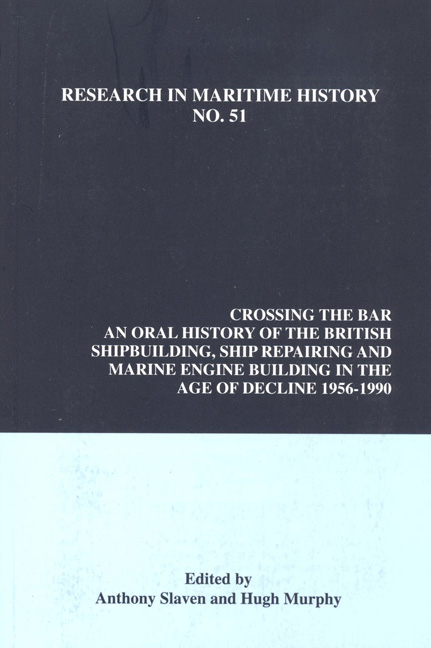 Crossing the Bar
Crossing the Bar Book contents
- Frontmatter
- Contents
- About the Authors
- Dedication
- Preface: A Shipbuilding Libretto
- Introduction
- Interviews
- Lower Clyde
- Upper Clyde
- The Tyne
- The Wear
- Barrow-in-Furness
- The South Coast
- The Humber
- Belfast
- British Shipbuilding Industry Officials
- 33 R.D. Brown, SRNA, AWES
- 34 Joseph Charles Asher, SEF, Shipbuilding Conference, BSRA
- 35 G.R. Snaith, BSRA, British Shipbuilders Plc
- The Trade Unions
- The Civil Servants, Board of Trade, Shipbuilding Enquiry Committee, Shipbuilding Industry Board, Ministry of Technology, Department of Trade and Industry, Department of Industry
- The Politicians
- Interviews British Shipbuilders Plc
- Conclusion
- Select Bibliography
33 - R.D. Brown, SRNA, AWES
from British Shipbuilding Industry Officials
- Frontmatter
- Contents
- About the Authors
- Dedication
- Preface: A Shipbuilding Libretto
- Introduction
- Interviews
- Lower Clyde
- Upper Clyde
- The Tyne
- The Wear
- Barrow-in-Furness
- The South Coast
- The Humber
- Belfast
- British Shipbuilding Industry Officials
- 33 R.D. Brown, SRNA, AWES
- 34 Joseph Charles Asher, SEF, Shipbuilding Conference, BSRA
- 35 G.R. Snaith, BSRA, British Shipbuilders Plc
- The Trade Unions
- The Civil Servants, Board of Trade, Shipbuilding Enquiry Committee, Shipbuilding Industry Board, Ministry of Technology, Department of Trade and Industry, Department of Industry
- The Politicians
- Interviews British Shipbuilders Plc
- Conclusion
- Select Bibliography
Summary
I qualified from Aberdeen University in 1937, and then spent a year at a law firm in Glasgow, before deciding there was little prospect of success there. I came down to London in 1938 and joined the British shipbuilding industry's commercial association called the Shipbuilding Conference [est. 1928]. The Chairman at the time was Sir Amos Ayre, who with his brother, Wilfrid had founded the Burntisland shipyard in Fife after the Great War. The second in command was Alexander Belch, whose son was Ross Belch later Managing Director of Scott Lithgow. I eventually became joint secretary of the SRNA, formed by the amalgamation of the Shipbuilding Conference and the Shipbuilding Employers Federation in the mid 1960s. Eventually, when the senior people died, I became Deputy Director in 1970 or 1971. I served in this capacity until the SRNA was disbanded on the advent of nationalisation in 1977 under its Director, Cliff Baylis. I then retired, refusing to go and to join British Shipbuilders, and then became Director of the Association of West European Shipbuilders until 1983.
One must remember that most of the shipbuilding yards in the UK are upriver, and very few of them lie directly on the sea. The glut of orders post- 1945 prevented them from modernising their yards. Most of them were cramped for space on sometimes very narrow rivers, and therefore could not go for the very large ships that the new European shipyards and those in the Far East, who started from nothing, could deal with. This was one of the major reasons why the shipbuilding industry in the UK reduced her chances of survival.
The strength of the industry was the yards were all independent of each other, and yet very co-operative in certain directions, for example, on research. They would help each other in times of need, while still being highly competitive, one against the other. There was little or no co-operation on the financial side, only on the technical side for the presentation to the outside world. One of the major difficulties was the attitude of the trade unions in the post-1945 period.
- Type
- Chapter
- Information
- Crossing the BarAn Oral History of the British Shipbuilding, Ship Repairing and Marine Engine-Building Industries in the Age of Decline, 1956-1990, pp. 143 - 145Publisher: Liverpool University PressPrint publication year: 2013
